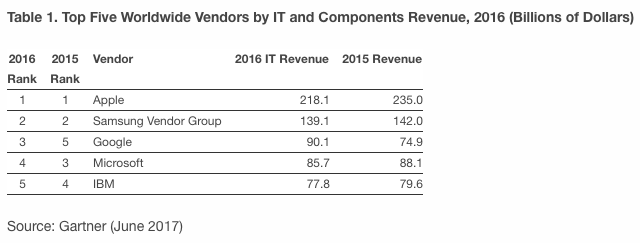Apple No. 1 Spot In Gartner Top 100 Vendors in IT LIst
Gartner, Inc. has unveiled the top global 100 vendors in IT in 2016 based on their revenue across IT (excluding communication services) and component market segments.
In the Gartner Global Top 100: IT vendors, Apple was the largest vendor with more than $218 billion in IT revenue approximately $79 billion larger than the No. 2 vendor, Samsung Vendor Group (see Table 1). Gartner analysts presented these findings during the Gartner Tech Growth & Innovation Conference on June 19.
For the first time, Gartner has published a ranking of the top 100 largest tech companies in the world based on estimates for their revenue across IT (excluding communication services) and component market segments. Technology business leaders can use the Gartner Global Top 100: IT to benchmark competitive performance against a shift from the Nexus of Forces (the convergence of social, mobility, cloud and information that drive new business scenarios) to digital business as the driver of IT purchasing.
“The needs of IT buyers are shifting. CEOs are focused on growth and are more focused on realizing business outcomes from their IT spend,” said John-David Lovelock, vice president and distinguished analyst at Gartner. “The Nexus of Forces has been the focus of attention for many years, however, the impact of digital business is giving rise to new categories.”

The top three vendors (Apple, Samsung Vendor Group and Google) can attribute much of their size to their solid alignment with the Nexus of Forces. Microsoft was a large and influential company when the Nexus of Forces began, having grown to market leadership during the web and e-business phase, and has managed to pivot to remain relevant. IBM gained its size and market dominance in the very earliest IT markets when servers, storage and consulting services dominated. The need for these devices and services, along with mobile phones and PCs will remain cloud will underpin all digital business initiatives but they will become more commoditized and less of a driver for new projects and spending.
Digital Giants Will Leave Their Mark in 2017
As enterprises increasingly digitalize their products and services, digital giants (Google, Apple, Facebook, Amazon, Baidu, Alibaba and Tencent) can become involved in, or even take over, the digital experience. Gartner predicts that by 2021, 20 percent of all activities an individual engages in will involve at least one of the top seven digital giants.
“Digital giants effectively become gatekeepers for any business that delivers digital content and services to consumers,” said Mr. Lovelock. “Any company that wants to engage consumers in, or through, their digital world will have to consider engaging with one or more of these digital giants.”
The focus of the digital giants has mainly been in the consumer, citizen and employee world. Because the digital giants have not yet been as focused on business to business (B2B), there is opportunity for other companies to take the lead.
“In the B2B world of selling technology solutions to large enterprises, some of the digital giants have already had significant impact,” said Mr. Lovelock. “For example, Amazon Web Services’ cloud is disrupting enterprise hardware and software businesses dramatically. Apple’s iOS devices are dominant within enterprise mobility, and Google’s presence beyond search into browsers, cloud office and more is growing.”
Gartner clients can learn more in the report “Market Insight: Gartner Global Top 100 IT Vendors in 2016.” This report features Gartner’s ranking of IT companies by their revenue across IT (excluding communication services) and components market segments to help technology business unit leaders with their business planning, investment prioritization and competitive benchmarking. It is based on Gartner Vendor Revenue Profiles, which represent Gartner’s analysis of a vendor’s reported revenue mapped to Gartner’s market segmentation. A “vendor,” for the purpose of a Vendor Revenue Profile, is defined as a trading entity that sells a finished product either into a channel or directly to end users. A trading entity can be a subsidiary, joint venture, or division as long as they maintain a separate marketing, sales and customer support structure independent of the parent company or companies.
Data for all 100 vendors in the Gartner Global Top 100: IT can be found on Gartner’s Vendor Revenue Profile portal. This interactive tool can be used to perform dynamic comparisons between vendor revenue across Gartner market segments to gain additional insight into the competitive landscape within various market segments and into the sources of revenue across a vendor’s product portfolio.
For more information, visit
http://gartner.com
Source: Gartner Inc.
